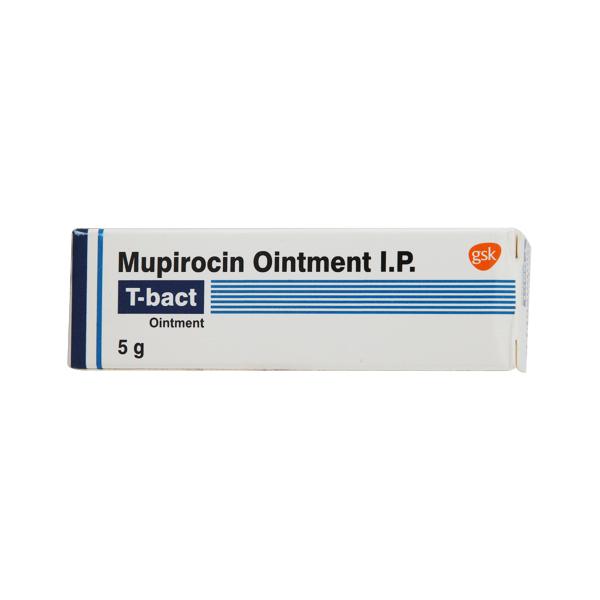Mupirocin
DEFINITION
Mupirocin is a topical antibiotic drug.
PURPOSE
Mupirocin is used to treat primary and secondary skin infections with Staphylococcus aureus and Staphylococcus pyogenes.
Primary skin infections occur in healthy skin. Secondary skin infections affect skin that has been injured or burned or occur within a surgical incision.
S. aureus and S. pyogenes skin infections are called impetigo.
Mupirocin is also used intranasally (in the nose) to eliminate the presence of methicillin-resistant Staphylococcus aureus (MRSA).
This organism can live in the nose without causing symptoms but can be passed to other vulnerable people who may develop an infection from the bacteria.
Off-Label Uses
Mupirocin has been used intranasally to prevent surgical incision infections in surgical patients who may have MRSA growing in their nostrils.
DESCRIPTION
Mupirocin is available as a cream, an ointment, and an intranasal ointment.
U.S. brand names for Mupirocin
Mupirocin is sold under the brand names Bactroban, Bactroban Nasal, Centany, and Centany AT. It is also manufactured as a generic by many different companies.
Canadian brand names
Mupirocin is sold under the brand name Bactroban in Canada.
International brand names
Mupirocin is sold under a variety of brand names internationally.
For example, it is sold as Bacidal in Thailand, Bactifree in the Philippines, Dimsa in Argentina, Hevronaz in Greece, Pitocin in India, Sinpebac in Mexico, and Trego in Bangladesh.
RECOMMENDED DOSAGE
Dosage recommendations apply to adults, pediatric patients, and geriatric patients:
- For primary skin infections (impetigo), apply ointment to lesions three times a day. Improvement should be noted within three to five days; the treatment plan should be reassessed if none is noted.
- For secondary skin infections (e.g., infections within wounds, lacerations, burns, surgical incisions), apply the cream to the infected area three times a day for ten days. Improvement should be noted within three to five days; the treatment plan should be reassessed if none is noted.
- For eradicating intranasal MRSA, single-use tubes are dispensed. Half should be used in each nostril twice a day for five days.
PRECAUTIONS
The following mupirocin warnings and precautions apply to all individuals:
- This drug should be taken for the entire length of the prescription. Failure to take a complete course of the medication can result in the return of symptoms.
- Use over a long period of time can increase the risk of developing another fungal or bacterial infection (secondary infection).
- difficile-associated diarrhea and pseudomembranous colitis have both been associated with the long-term use of mupirocin, even months after the drug has been discontinued.
Pregnant or breastfeeding
Mupirocin carries the FDA pregnancy category B, meaning that studies in animals have found no risk to the developing fetus.
Women who are pregnant or breastfeeding should tell their doctor before taking mupirocin.
Other conditions and allergies
Individuals who are allergic or who have had reactions to mupirocin should not use this drug.
Individuals with a history of severe allergies, asthma, or prior reactions involving anaphylaxis, hives, or the severe swelling called angioedema are at higher risk of serious reactions to mupirocin.
SIDE EFFECTS
Serious and sometimes fatal reactions can occur in individuals who are allergic to penicillin and penicillin-like drugs.
Anyone who has had a severe reaction to any drug should alert the physician before taking this drug.
The most common adverse side effects of mupirocin for all age groups tend to be mild. They include:
- headache
- burning, stinging, or pain in the affected area being treated
- burning and/or tearing of the eyes
- itching
- rash
- nausea
- changes in the sensation of taste during use of the drug
- congested or runny nose
- sore throat
- cough
These side effects should be brought to the doctor’s attention if they do not go away within a few days.
A doctor should be notified immediately if any of these less common but more serious side effects occur:
- wheezing, difficulty breathing or swallowing; may indicate a severe allergic reaction and require immediate medical attention
- severe skin rash, itching, or hives
- swelling
INTERACTIONS
Pharmaceutical drugs may interact with other pharmaceuticals, herbs, dietary supplements, and foods.
Drug interactions can increase or decrease the drug’s effectiveness or increase the risk of serious side effects.
Patients must tell the prescribing doctor about all the medications they are taking, including nonprescription (over-the-counter) medications, herbs, and dietary supplements, including vitamin supplements.
Drugs
Because mupirocin is not systemic, there have been few reported drug interactions.
However, antibiotics are known to decrease the therapeutic effect of the BCG vaccine, typhoid vaccine, and actions of sodium picosulfate.
It is advisable to delay immunization until at least 24 hours after the last use of an antibiotic.
KEY TERMS
Anaphylaxis—
- A severe, systemic allergic reaction that can be potentially life-threatening.
MRSA—
- Methicillin-resistant Staphylococcus aureus, a staphylococcal organism, has developed the ability to resist killing many conventional antibiotics.
Resistance—
- A characteristic developed by some organisms that allow them to escape the effects of certain antibiotics.
Secondary infection—
- An infection by a microbe occurs because the body is weakened by a primary infection caused by a different kind of microbe, also called an opportunistic infection.
Systemic—
-
- A term used to describe a medicine that affects the body instead of topical drugs that work on the skin. Most medicines that are taken by mouth or by injection are systemic drugs.
Resources
BOOKS
Bennett, John E., Raphael Dolin, and Martin J. Blaser. Mandell, Douglas, and Bennett’s Principles and Practice of Infectious Diseases. 8th ed. Philadelphia: Saunders, 2014.
Cherry, James, et al. Feigin and Cherry’s Textbook of Pediatric Infectious Diseases. 7th ed. Philadelphia: Saunders, 2014.
Lexicomp. Drug Information Handbook. 23rd ed. Hudson, OH: Lexicomp Inc., 2014.
Magill, Alan, et al. Hunter’s Tropical Medicine and Emerging Infectious Diseases. Philadelphia: Saunders, 2013.
Rang, Humphrey, et al. Rang, and Dale’s Pharmacology. 7th ed. London: Churchill Livingstone, 2012.
WEBSITES
MedlinePlus. “Mupirocin.” U.S. National Library of Medicine, National Institutes of Health. http://www.nlm.nih.gov/medlineplus/druginfo/meds/a688004.html (accessed February 23, 2015).
“Mupirocin Nasal.” Drugs.com. http://www.drugs.com/mtm/mupirocin-nasal.html (accessed February 23, 2015).
U.S. National Library of Medicine. “LactMed: Mupirocin.” TOXNET. http://toxnet.nlm.nih.gov/cgi-bin/sis/search2/r?dbs+lactmed:@term+@DOCNO+548 (accessed February 23, 2015).
ORGANIZATIONS
Centers for Disease Control and Prevention (CDC), 1600 Clifton Road, Atlanta, GA 30329, (404) 639-3534, (800) CDC-INFO (800-232-4636), TTY: (888) 232-6348, [email protected], http://www.cdc.gov/ .
U.S. Food and Drug Administration (FDA), 10903 New Hampshire Avenue, Silver Spring, MD 20993, (888) INFO-FDA (463-6332), http://www.fda.gov/.
Rosalyn Carson-DeWitt, MD
REVIEWED BY KEVIN GLAZA, RPH








